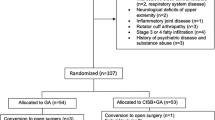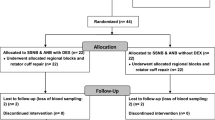Abstract
Purpose
The purpose of this study was to evaluate the outcomes of arthroscopy-guided direct suprascapular nerve block performed after arthroscopic rotator cuff repair.
Methods
In the present prospective, randomized, double-blinded clinical study, 30 patients were divided into two groups: 15 patients (group I) were treated with arthroscopy-guided suprascapular nerve block using 10 mL 0.5 % ropivacaine with 1:200,000 epinephrine, and 15 patients (group II) were treated with placebo using 10 mL 0.9 % saline after arthroscopic rotator cuff repair. Patient pain levels were measured using the visual analog scale (VAS) at 1, 3, 6, 12, 18, and 24 h post-operatively. Additionally, the number of boluses and total amount of fentanyl dispensed by patient-controlled analgesia administration during the 24-h post-operative period were evaluated.
Results
VAS scores did not differ significantly between groups I and II during the 24-h post-operative period, but mean fentanyl bolus consumption was significantly less in group I compared with group II (p = 0.015).
Conclusion
Arthroscopy-guided suprascapular nerve block at the end of a rotator cuff repair was safe and less time-consuming than expected. Although this procedure did not significantly reduce the post-operative pain, the post-operative need for fentanyl boluses as analgesia was reduced significantly, and it would be beneficial if this procedure involved a sensory branch of axillary nerve block or was performed at the beginning of the arthroscopic procedure.
Level of evidence
Prospective, randomized, double-blinded clinical trial, Level I.
Similar content being viewed by others
References
Al-Kaisy A, McGuire G, Chan VW et al (1998) Analgesic effect of interscalene block using low-dose bupivacaine for outpatient arthroscopic shoulder surgery. Reg Anesth Pain Med 23:469–473
Capdevila X, Dadure C, Bringuier S et al (2006) Effect of patient-controlled perineural analgesia on rehabilitation and pain after ambulatory orthopedic surgery: a multicenter randomized trial. Anesthesiology 105:566–573
Checcucci G, Allegra A, Bigazzi P, Gianesello L, Ceruso M, Gritti G (2008) A new technique for regional anesthesia for arthroscopic shoulder surgery based on a suprascapular nerve block and an axillary nerve block: an evaluation of the first results. Arthroscopy 24:689–696
Coghlan JA, Forbes A, McKenzie D, Bell SN, Buchbinder R (2009) Efficacy of subacromial ropivacaine infusion for rotator cuff surgery. A randomized trial. J Bone Joint Surg Am 91:1558–1567
Doss NW, Splain SH, Crimi T, Michael R, Abadir AR, Gintautas J (2001) Intra-articular morphine, ropivacaine, and morphine/ropivacaine for pain control after arthroscopy: preliminary observation. Proc West Pharmacol Soc 44:195–196
Emery P (1989) Suprascapular nerve block for chronic shoulder pain in rheumatoid arthritis. Br Med J 299:1079–1080
Eustace JA, Brophy DP, Gibney RP, Bresnihan B, FitzGerald O (1997) Comparison of the accuracy of steroid placement with clinical outcome in patients with shoulder symptoms. Ann Rueum Dis 56:59–63
Fontana C, Di Donato A, Giacoma G et al (2009) Postoperative analgesia for arthroscopic shoulder surgery: a prospective randomized controlled study of intraarticular, subacromial injection, interscalene brachial plexus block and intraarticular plus subacromial injection efficacy. Eur J Anaesthesiol 26:689–693
Fujimuta N, Namba H, Tsunoda K et al (1995) Effects of hemidiaphragmatic paresis caused by interscalene plexus block on breathing pattern, chest wall mechanics, and arterial blood gases. Anesth Analg 81:962–966
Harmon D, Hearty C (2007) Ultrasound-guided suprascapular nerve block technique. Pain Physician 10:743–746
Jerosch J, Saad M, Greig M, Filler T (2008) Suprascapular nerve block as a method of preemptive pain control in shoulder surgery. Knee Surg Sports Traumatol Arthrosc 16:602–607
Jeske HC, Kralinger F, Wambacher M et al (2011) A randomized study of the effectiveness of suprascapular nerve block in patient satisfaction and outcome after arthroscopic subacromial decompression. Arthroscopy 27:1323–1328
Jones A, Regan M, Hedingham J, Pattrick M, Manhire A, Doherty M (1993) Importance of placement of intra-articular injections. BMJ 307:1329–1330
Laurila PA, Lopponen A, Kangas-Saarela T, Flinkkila T, Salomaki TE (2002) Interscalene brachial plexus block is superior to subacromial bursa block after arthroscopic shoulder surgery. Acta Anaesth Scand 46:1031–1036
Lenters TR, Davies J, Matsen FA 3rd (2007) The types and severity of complications associated with interscalene brachial plexus block anesthesia: local and national evidence. J Shoulder Elbow Surg 16:379–387
Moote C (1994) Random double-blind comparison of intra-articular bupivacaine and placebo for analgesia after outpatient shoulder arthroscopy. Anesthesiology 81:A49 (abstract)
Pippa P, Cominelli E, Marinelli C, Aito S (1990) Brachial plexus block using the posterior approach. Eur J Anaesthesiol 7:411–420
Pizzi LT, Toner R, Foley K, Thomson E, Chow W, Kim M, Couto J, Royo M, Viscusi E (2012) Relationship between potential opioid-related adverse effects and hospital length of stay in patients receiving opioids after orthopedic surgery. Pharmacotherapy 32:502–514
Ritchie ED, Tong D, Chung F, Norris M, Miniaci A, Vairavanathan SD (1997) Suprascapular nerve block for postoperative pain relief in arthroscopic shoulder surgery: a new modality? Anesth Analg 84:1306–1312
Schneider-Kolsky ME, Pike J, Connell DA (2004) CT-guided suprascapular nerve blocks: a pilot study. Skeletal Radiol 33:277–282
Singelyn FJ, Lhotel L, Fabre B (2004) Pain relief after arthroscopic shoulder surgery: a comparison of intraarticular analgesia, suprascapular nerve block, and interscalene brachial plexus block. Anesth Analg 99:589–592
Stoker DJ (1991) Intra-articular injections in capsulitis (letter). BMJ 303:123
Wassef MR (1992) Suprascapular nerve block: a new approach for the management of frozen shoulder. Anaesthesia 47:120–124
White AET, Tuite JD (1996) The accuracy and efficacy of shoulder injections in restrictive capsulitis. J Orthop Rheumatol 9:37–40
Author information
Authors and Affiliations
Corresponding author
Rights and permissions
About this article
Cite this article
Lee, J.J., Yoo, YS., Hwang, JT. et al. Efficacy of direct arthroscopy-guided suprascapular nerve block after arthroscopic rotator cuff repair: a prospective randomized study. Knee Surg Sports Traumatol Arthrosc 23, 562–566 (2015). https://doi.org/10.1007/s00167-013-2451-x
Received:
Accepted:
Published:
Issue Date:
DOI: https://doi.org/10.1007/s00167-013-2451-x




